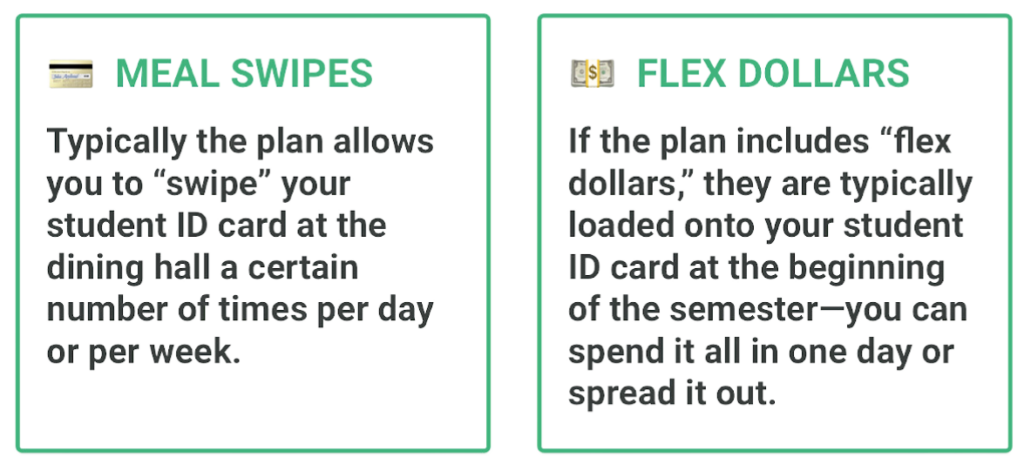Housing and Meals Explained
After tuition costs, the second largest fee you’ll see on your college bill will be for room and board.
On-campus housing and meal plans are helpful as you navigate through school. As you may have seen in DecidED, we ask where you expect to live when you upload your award letters. Your options are:
- Living in a dorm on-campus
- Your college bill will include both your housing and food costs.
- Check to see if your college offers guaranteed on-campus housing and for how many years. Some colleges may only offer on-campus housing for first-year students. Housing availability and off-campus rent costs could significantly affect your total cost throughout your four years.
- Living with family at home
- You may not have dorm or food costs as part of your college bill, but you may need to budget for these associated costs under your life budget. DecidED can provide you with estimates.
- Living in an off-campus apartment
- Some colleges may require first year students to live on campus during their first year, make sure to check and confirm with the college.
- Your college should have provided an estimated amount you will need to cover off-campus housing and food costs. These costs will be under your life budget if they are not paid to the college.
- Not sure!
- If you are not sure whether to live on or off campus, DecidED will show you estimated on-campus costs (you can update this as needed).

Tip: Your housing situation changes the total costs you may need to budget for. Housing costs can significantly affect what you end up paying and budgeting in regards to food costs (meal plans).
How many meals do I really need at college?
If you plan on living on-campus, you will most likely be required to select a meal plan option. Your college may offer different options. Knowing your meal habits and needs can help you select the right option for you. This guide will break down how a meal plan works, what is recommended as a basic meal plan, and hacks for spending less money on food.

Meal Plan 101: Terminology
Dining Hall: Similar to a cafeteria, the dining hall usually has different stations you can order food from. Most dining halls function as an all-you-can-eat buffet.
À la Carte: Some colleges allow you to eat elsewhere (outside of their dining hall options) by purchasing meal swipes or points as needed outside of a full meal plan. Depending on how much meals cost in direct cash, you may want to purchase a small amount of points or swipes to use occasionally or to supplement a meal plan that is running low.
Food Court: You will have a selection of restaurants and/or fast-food eateries operating on or near the college that may accept students’ meal plans as a method of payment.
Guest Pass: Some meal plans may come with guest passes that can be given to a friend or family member who is visiting you. Guest meal passes are more common on campuses that have per-meal plans rather than point plans.
Types of meal plans
Two or fewer meals daily: Cost the least, but also give you fewer meal points or fewer meal swipes, depending on how the college structures the plan. A light plan may, for example, give you access to 14 meals a week (which means two meals per day, including weekends).
Two to three meals daily: Give you access to standard three daily meals (breakfast, lunch and dinner) through meal swipes or points.
Three or more meals daily: Give you enough points or swipes to eat beyond a standard daily three-meal plan. A few colleges even offer limitless plans that allow you to eat as much and as often as you want, although this costs significantly more than other potential plans.
Commuter/Off-Campus meal plans: This type of plan is a step below “light” plans. Depending on the college, they can give you enough points or swipes for one on-campus meal a day.

How a meal plan works
Here are some examples of what a meal plan could look like at your school. Note that some plans just offer “meal swipes” while others offer a combination of “meal swipes” and “flex dollars.”

How swipes work: Swipes are the amount of meals that you will be given per week. These meals are served at locations such as dining halls, commons, or on-campus restaurants. Swipes usually comprise breakfast, lunch and dinner. These meals are usually buffet style, so fill up to your heart’s content!
Tip: You can only use these meals at designated locations, meaning that you will have to travel back to these locations throughout the day for your meals and you should plan accordingly.
Typically, meal plans don’t always “roll over” to the next semester. This means that whatever you don’t use this semester, you lose!
How flex dollars work: Flex dollars count as money that you can use at any location on campus. Flex dollars can be used to buy anything from coffee to snacks to school supplies.
Tip: Your flex dollars fly fast! You only get a certain amount per semester, so make sure to keep an eye on how many you have before you splurge on snacks.
Start with less, then upgrade
In general, you will need less food than you think. If you are living on campus, we recommend that you go with a plan that allows you to eat at least twice a day (14 meals per week). Typically, colleges let you upgrade your meal plan at any time so we recommend that you start with a smaller meal plan and then upgrade to a bigger one if you find that you need it.
Tip: Double check that your school’s meal plan policy allows you to upgrade in the middle of the semester. You can sometimes find this information on the college website under dining/meal plans under their FAQs. If it’s not listed there make sure to reach out to the college dining halls or general office at the school to confirm.
Tips for eating more and spending less
- Pack tupperware in your backpack so that you can fill it with food during one of your meals.
- Consider purchasing a mini-fridge that you can use for your college career or use the refrigerator in your dorm’s communal kitchen.
- Note: Not all dorms have kitchens and when they do, fridge space can be limited.
- It’s also worth looking for a free fridge from graduating seniors who are giving away their stuff.
- Find free food at clubs and school events.
- More and more schools now have a food pantry on-campus so check into this option if you find yourself tight on money.
What if I’m not living on campus?
If you are commuting to school, then we recommend seeing if your school offers a commuter meal plan.
The reasons we suggest this is because:
- You will be spending all day on campus and will get hungry. This means that you will end up purchasing food either on campus at full price, or at a surrounding restaurant.
- Storing food is going to be challenging. Finding a refrigerator to store your food or a microwave to warm it up can be difficult.
- Eating with other students in the dining commons is the best way to make friends! This is your time to relax, unwind, and talk about what interests you or bond over the same struggles you are going through.
What if I am not living on campus due to Covid-19?
Then you are essentially commuting to school, even if you intended to live on campus. The good news here is that you don’t need to spend money on food on or around your college campus. This could mean you’re spending more on food where you now live. Your school may already have an emergency aid program setup to help support you with your basic needs.
For more tips and tricks for finding the most affordable plan, click check out this information from Affordable Colleges Online.








